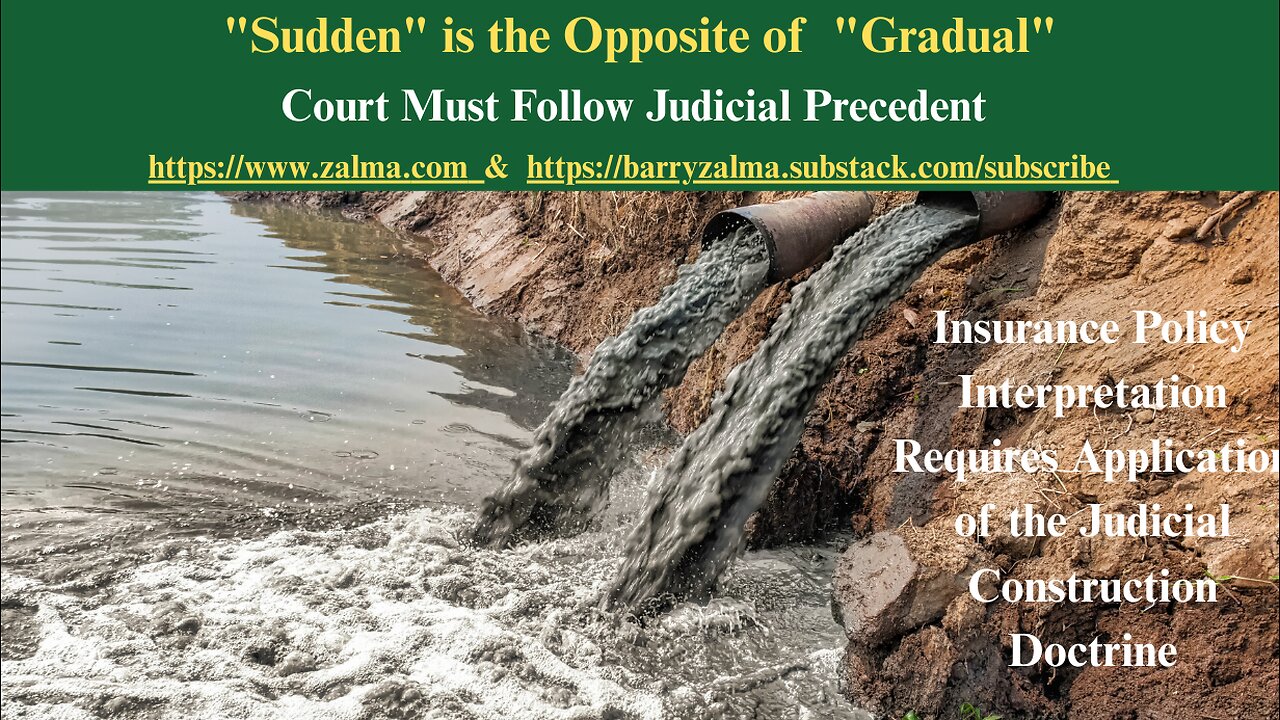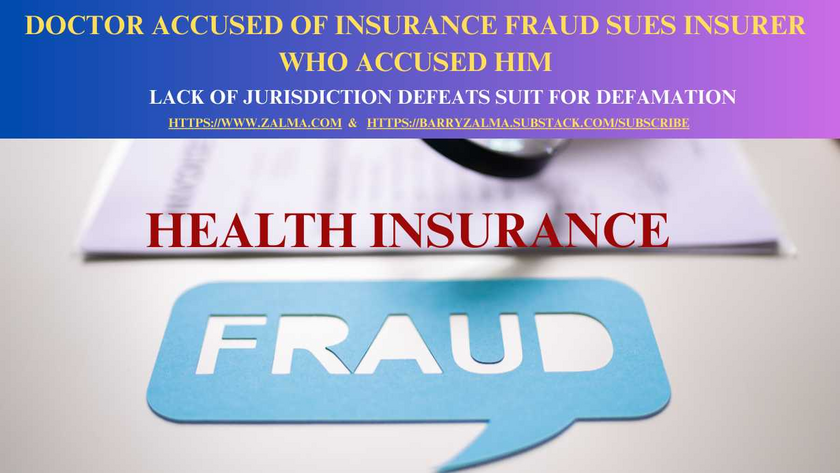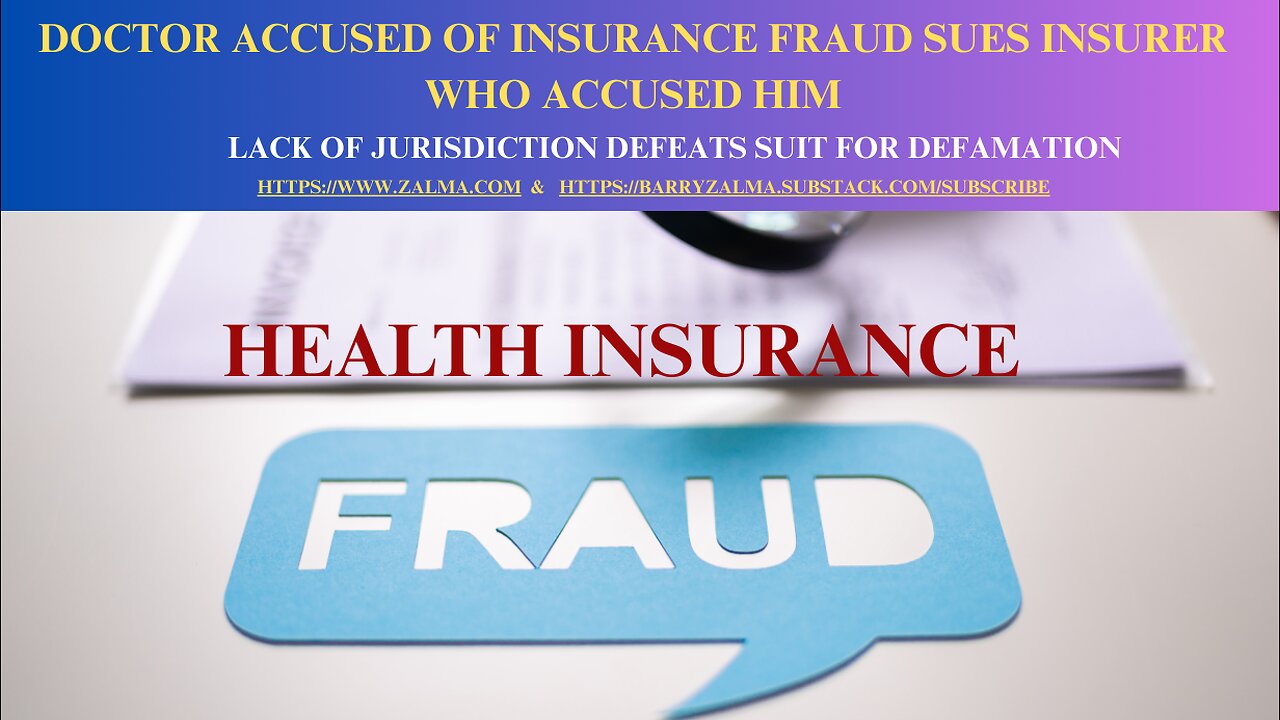
Business Pursuits Exclusion Defeats Claim
Barry Zalma
Read the full article at https://lnkd.in/gpfR_Mx2 and see the full video at https://lnkd.in/gCfgYqDw and at https://lnkd.in/gd9mH8ea and at https://zalma.com/blog plus more than 4450 posts.
In a declaratory judgment action to determine whether the plaintiffs were obligated to defend and indemnify the named defendant under certain insurance policies for damages awarded against the named defendant in a separate action, where the court denied the plaintiffs’ motion for summary judgment and granted the motion for summary judgment filed by the named defendant et al. as to the duty to defend under the policies. In Nationwide Mutual Insurance Company et. al. v. Jeffrey S. Pasiak et al., No. SC 20617, Supreme Court of Connecticut (February 21, 2023) Nationwide asked the Supreme Court to apply its business pursuits exclusion.
This case reached the Supreme Court for the second time following lengthy litigation of a declaratory judgment action brought by the plaintiffs, Nationwide Mutual Insurance Company and Nationwide Mutual Fire Insurance Company, against the defendant Jeffrey S. Pasiak. The action concerned whether the plaintiffs were obligated to indemnify the defendant, a business owner, under a personal umbrella insurance policy for liability arising from his false imprisonment of his company’s employee at her workplace.
The trial court rendered judgment for the plaintiffs, concluding that they have no obligation to indemnify the defendant. The defendant appealed.
FACTS
The defendant owned Pasiak Construction Services, LLC (Pasiak Construction), which had its sole office in the defendant’s home in Stamford. The defendant maintained a homeowners insurance policy and an umbrella insurance policy through the plaintiffs at the time of the incident. He did not hold any commercial liability insurance for his business.
Pasiak Construction employed Sara Socci as a part-time office manager with working hours of 9:30 a.m. to 2:30 p.m., four days per week. Socci worked out of the office in the defendant’s home and would help with both the defendant’s business tasks and personal tasks. One day in May, 2006, Socci was working at her desk when an individual entered the office wearing a mask and carrying a gun. The individual demanded that Socci show him to the defendant’s safe and open it. Socci had no knowledge of the safe or its combination. The individual became enraged, and he bound, gagged, and blindfolded Socci and forced her down on the floor of the bedroom. He put a gun to her head and told her he would kill her and her family if she did not open the safe.
The defendant eventually returned home and was attacked by the individual at the top of the stairs. The defendant was eventually able to unmask the individual, revealing his identity to be Richard Kotulsky, a longtime friend of the defendant. When the defendant asked about Socci’s whereabouts, Kotulsky led him to the bedroom, where the defendant made Kotulsky untie Socci. The defendant and Kotulsky reached some degree of resolution of their dispute and spoke amicably.
Despite Socci’s requests to leave, the defendant prevented her from leaving. Following Kotulsky’s exit, Socci resigned from Pasiak Construction and informed the defendant that she could no longer work for him because she was terrified that Kotulsky would return. The trial court also noted that she felt intimidated because the defendant and Kotulsky were each twice as large as she was.
Socci, her husband, and a friend later returned to the defendant’s home, at which point the defendant called the police. After being charged with kidnapping in the second degree and witness tampering, the defendant pleaded guilty under the Alford doctrine to charges of interfering with an officer and threatening in the second degree. Socci and her husband sued the defendant, alleging false imprisonment, negligence, intentional, reckless and negligent infliction of emotional distress, and loss of consortium. The plaintiffs provided the defendant with an attorney to defend him in the Socci action but notified him that they were reserving their right to contest coverage.
The plaintiffs then sued seeking a declaration that they had no duty to defend or indemnify the defendant in the Socci action. The trial court concluded, by way of summary judgment, that the allegations of the complaint were sufficiently broad to obligate the plaintiffs to provide the defendant with a defense under his homeowners and umbrella insurance policies, but the court deemed it improper, at that juncture, to determine the plaintiffs’ duty to indemnify.
Socci and the defendant proceeded to trial in the tort action, in which the jury awarded Socci $628,200 in compensatory damages and $175,000 in punitive damages. The jury also awarded Socci’s husband $32,500 in compensatory damages. The plaintiffs then filed a second motion for summary judgment in the declaratory judgment action regarding their duty to indemnify the defendant. The plaintiffs argued, among other things, that the defendant’s policies did not cover his liability for the Socci action because coverage was barred under the policy exclusion for business pursuits.
The court concluded that the plaintiffs were entitled to summary judgment under the homeowners insurance policy-which did not cover injury for emotional distress unless caused by a physical injury-but not under the umbrella insurance policy-which covered “personal injury,” defined to include false imprisonment.
The trial court issued a decision and rendered judgment for the defendant, requiring the plaintiffs to indemnify the defendant for his liability in the Socci action. The Supreme Court reversed the judgment of the Appellate Court with direction to remand the case to the trial court for a trial de novo on the business pursuits exclusion issue. The trial court concluded that the plaintiffs satisfied their burden by a preponderance of the evidence.
ANALYSIS
There is a distinction between the standard of proof in a civil trial and the interpretive presumptions the Supreme Court applies to insurance contracts. The interpretation of an insurance contract is “a question of law,” not a matter of fact.
No one questions that the activities of Pasiak Construction meet the two elements of a business pursuit. Nor does anyone contend that false imprisonment constitutes a business pursuit. Therefore, the question is whether the defendant’s false imprisonment of Socci arose out of his business pursuits in operating Pasiak Construction.
The Supreme Court concluded that it is sufficient to show only that the accident or injury was connected with, had its origins in, grew out of, flowed from, or was incident to the specified subject in order to meet the requirement that there be a causal relationship between the accident or injury and the subject.
The Supreme Court concluded that the defendant’s remaining claims were without merit, and the judgment of the trial court should be affirmed. Specifically, the Supreme Court concluded that:
1 the trial court did not err when it found in the plaintiffs’ favor on the basis that they failed to produce new, credible evidence that was not raised during the first trial, and
2 with respect to the second and third claims, the record, viewed as a whole, contains evidence that supports the factual findings of the trial court.
CONCLUSION
The trial court properly applied the preponderance of the evidence standard at the trial de novo to determine the factual question of whether the plaintiffs established that the business pursuits exclusion of the umbrella insurance policy barred coverage. It did, and the judgment was affirmed.
ZALMA OPINION
A construction company seeking insurance protection usually needs a commercial general liability (CGL) policy to protect its commercial interests. A homeowners policy, like that issued by Nationwide is designed to protect against the liability faced by a homeowner, not a business, and exclude coverage for business pursuits. In this case, as part of the defendant’s business a jury found he wrongfully imprisoned his employee and caused her and her husband tort damages. The exclusion applied and the insurer was not required to indemnify the insured although it was required to defend him to the allegations of the employee’s suit. The insured, Pasiak Construction, intentionally caused damage to an employee who was abused by a “friend” of Pasiak who held her at gunpoint and threatened to kill her and her family. Pasiak got more than he deserved with a full, paid for, defense. I expect Pasiak will file bankruptcy to avoid paying the judgment.
(c) 2023 Barry Zalma & ClaimSchool, Inc.
Subscribe and receive videos limited to subscribers of Excellence in Claims Handling at locals.com https://lnkd.in/gJm8mH_e
Follow Mr. Zalma on Twitter at https://twitter.com/bzalma; Go to Barry Zalma videos at Rumble.com at https://lnkd.in/gV9QJYH; Go to Barry Zalma on YouTube- https://lnkd.in/g2hGv88; Go to the Insurance Claims Library – https://lnkd.in/gWVSBde
Subscribe and receive videos limited to subscribers of Excellence in Claims Handling at locals.com https://zalmaoninsurance.locals.com/subscribe.
Go to substack at substack.com/refer/barryzalma Consider subscribing to my publications at substack at substack.com/refer/barryzalma
Barry Zalma, Esq., CFE, now limits his practice to service as an insurance consultant specializing in insurance coverage, insurance claims handling, insurance bad faith and insurance fraud almost equally for insurers and policyholders. He practiced law in California for more than 44 years as an insurance coverage and claims handling lawyer and more than 54 years in the insurance business. He is available at http://www.zalma.com and [email protected]
Write to Mr. Zalma at [email protected]; http://www.zalma.com; http://zalma.com/blog; daily articles are published at https://zalma.substack.com. Go to the podcast Zalma On Insurance at https://anchor.fm/barry-zalma; Follow Mr. Zalma on Twitter at https://twitter.com/bzalma; Go to Barry Zalma videos at Rumble.com at https://rumble.com/c/c-262921; Go to Barry Zalma on YouTube- https://www.youtube.com/channel/UCysiZklEtxZsSF9DfC0Expg; Go to the Insurance Claims Library – https://zalma.com/blog/insurance-claims-library
Posted on January 2, 2026 by Barry Zalma
ZIFL – Volume 30 Number 1
THE SOURCE FOR THE INSURANCE FRAUD PROFESSIONAL
See the video at https://rumble.com/v73nifg-zalmas-insurance-fraud-letter-january-2-2026.html and at https://youtu.be/vZC1e-_qwDg
Supreme Court of Louisiana Removes Judge
Judge Who Lied to Get Elected Cannot Serve
In In Re: Judge Tiffany Foxworth-Roberts, No. 2025-O-01127, Supreme Court of Louisiana (December 11, 2025) the Louisiana Supreme Court in an opinion by Chief Justice Weimer dealt with the recommendation of the Judiciary Commission of Louisiana (Commission) that Judge Tiffany Foxworth-Roberts be removed from office for:
1. making false and misleading statements regarding her judicial campaigns;
2. making false and misleading statements to police investigating the reported burglary of her car; and
3. withholding information and providing false, incomplete, or misleading information during the investigation by the Office of Special Counsel (OSC), as well as in the proceedings before the Commission....
Montana County Attorney Admits to Insurance Fraud & Is Only Suspended from Practice for 60 Days
Post 5251
Read the full article at https://lnkd.in/gnBaCjmv, see the video at https://lnkd.in/gfpVsyAd and at https://lnkd.in/gC73Nd8z, and at https://zalma.com/blog plus more than 5250 posts.
A Lawyer Who Commits Insurance Fraud and Pleas to a Lower Charge Only Suspended
In The Matter Of: Naomi R. Leisz, Attorney at Law, No. PR 25-0150, Supreme Court of Montana (December 23, 2025) the Montana Office of Disciplinary Counsel (ODC) filed a formal disciplinary complaint with the Commission on Practice (Commission) against Montana attorney Naomi R. Leisz.
On September 25, 2025, Leisz tendered a conditional admission and affidavit of consent. Leisz acknowledged the material facts of the complaint were true and she had violated the Montana Rules of Professional Conduct as alleged by ODC.
ADMISSIONS
Leisz admitted that in April 2022, her minor son was involved in a car accident in which he hit a power pole. Leisz’s son ...
Montana County Attorney Admits to Insurance Fraud & Is Only Suspended from Practice for 60 Days
Post 5251
Read the full article at https://lnkd.in/gnBaCjmv, see the video at https://lnkd.in/gfpVsyAd and at https://lnkd.in/gC73Nd8z, and at https://zalma.com/blog plus more than 5250 posts.
A Lawyer Who Commits Insurance Fraud and Pleas to a Lower Charge Only Suspended
In The Matter Of: Naomi R. Leisz, Attorney at Law, No. PR 25-0150, Supreme Court of Montana (December 23, 2025) the Montana Office of Disciplinary Counsel (ODC) filed a formal disciplinary complaint with the Commission on Practice (Commission) against Montana attorney Naomi R. Leisz.
On September 25, 2025, Leisz tendered a conditional admission and affidavit of consent. Leisz acknowledged the material facts of the complaint were true and she had violated the Montana Rules of Professional Conduct as alleged by ODC.
ADMISSIONS
Leisz admitted that in April 2022, her minor son was involved in a car accident in which he hit a power pole. Leisz’s son ...
Court Must Follow Judicial Precedent
Post 5252
Read the full article at https://www.linkedin.com/pulse/sudden-opposite-gradual-barry-zalma-esq-cfe-h7qmc, see the video at and at and at https://zalma.com/blog plus more than 5250 posts.
Insurance Policy Interpretation Requires Application of the Judicial Construction Doctrine
In Montrose Chemical Corporation Of California v. The Superior Court Of Los Angeles County, Canadian Universal Insurance Company, Inc., et al., B335073, Court of Appeal, 337 Cal.Rptr.3d 222 (9/30/2025) the Court of Appeal refused to allow extrinsic evidence to interpret the word “sudden” in qualified pollution exclusions (QPEs) as including gradual but unexpected pollution. The court held that, under controlling California appellate precedent, the term “sudden” in these standard-form exclusions unambiguously includes a temporal element (abruptness) and cannot reasonably be construed to mean ...


Lack of Jurisdiction Defeats Suit for Defamation
Post 5250
Posted on December 29, 2025 by Barry Zalma
See the video at and at
He Who Represents Himself in a Lawsuit has a Fool for a Client
In Pankaj Merchia v. United Healthcare Services, Inc., Civil Action No. 24-2700 (RC), United States District Court, District of Columbia (December 22, 2025)
FACTUAL BACKGROUND
Parties & Claims:
The plaintiff, Pankaj Merchia, is a physician, scientist, engineer, and entrepreneur, proceeding pro se. Merchia sued United Healthcare Services, Inc., a Minnesota-based medical insurance company, for defamation and related claims. The core allegation is that United Healthcare falsely accused Merchia of healthcare fraud, which led to his indictment and arrest in Massachusetts, causing reputational and business harm in the District of Columbia and nationwide.
Underlying Events:
The alleged defamation occurred when United ...


Zalma’s Insurance Fraud Letter
Read the full article at https://lnkd.in/dG829BF6; see the video at https://lnkd.in/dyCggZMZ and at https://lnkd.in/d6a9QdDd.
ZIFL Volume 29, Issue 24
Subscribe to the e-mail Version of ZIFL, it’s Free! https://visitor.r20.constantcontact.com/manage/optin?v=001Gb86hroKqEYVdo-PWnMUkcitKvwMc3HNWiyrn6jw8ERzpnmgU_oNjTrm1U1YGZ7_ay4AZ7_mCLQBKsXokYWFyD_Xo_zMFYUMovVTCgTAs7liC1eR4LsDBrk2zBNDMBPp7Bq0VeAA-SNvk6xgrgl8dNR0BjCMTm_gE7bAycDEHwRXFAoyVjSABkXPPaG2Jb3SEvkeZXRXPDs%3D
Zalma’s Insurance Fraud Letter (ZIFL) continues its 29th year of publication dedicated to those involved in reducing the effect of insurance fraud. ZIFL is published 24 times a year by ClaimSchool and is written by Barry Zalma. It is provided FREE to anyone who visits the site at http://zalma.com/zalmas-insurance-fraud-letter-2/
Zalma’s Insurance Fraud Letter
Merry Christmas & Happy Hannukah
Read the following Articles from the December 15, 2025 issue:
Read the full 19 page issue of ZIFL at ...













